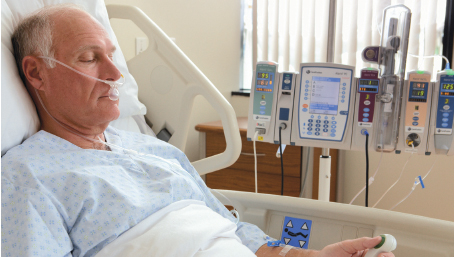By Timothy L.V. Wong (college intern with A Promise to Amanda Foundation, a non-profit working to ensure – “Monitor ALL PCA patients using Capnography – It Saves Lives”)
Patient Controlled Analgesia is the most common and effective form of pain treatment because it offers consistent and continuous pain relief. However, faults in current PCA technology are putting patients at risk everyday.
Before the 1960’s, personal pain control consisted of large doses of medication. These were administered bedside by nurses on a regular, but not frequent schedule or on demand if one felt pain. Dr. Benson B. Roe was the first to discover that smaller and more regular doses treated pain more effectively.
In the late 1960’s, Dr. Phillip H. Sechzer began to develop machines that could take the place of bedside nurses to provide pain relief through an IV anytime a patient experienced pain. This new technology was called Patient Controlled Analgesia or PCA. In 1976, the first PCA pump, Cardiff Palliator, was released and used commercially.
The “Smart” Pump was introduced next – a PCA pump that can be programmed by a healthcare professional. This mechanic limits the dose delivered each time the patient requires it and is meant to reduce the risk of overdose. Yet, there are fatal errors that still occur with “smart” pumps.
The tragic story of Amanda Abbiehl is a powerful example of the dangers of PCA use. On July 15, 2010, Amanda, an 18 year old girl, was admitted to a local hospital for treatment of a virus that was causing mouth and throat pain. She was placed on a PCA pump to allow her to control when the pain medication was administered. The next morning Amanda was found unresponsive and died.
The most recent PCA pump in its evolution allows safer use through the use of Capnography and Pulse Oximetry. Capnography is a device that monitors a patient’s CO2 output. Unlike its predecessor, a drop in the adequacy of ventilation immediately shuts off the PCA pump and an alarm is also sounded to alert nearby nurses of the patient’s declining health. This “forcing function” does not allow the prescribed sedative to be administered until the patient has been assessed by a healthcare professional.
As Bryanne Patail, biomedical engineer at the U.S. Department of Veterans Affairs (VHA), National Center for Patient Safety explains:
The strongest fix for PCA pumps is a forcing function, such as an integrated end tidal CO2 monitor that will pause the pump if a possible over infusion occurred.
The VHA says using PCA pumps with integrated capnography “could prevent more than 60 percent of adverse events related to PCA pumps”.
If adverse events and deaths still occur with “smart” pumps, like that of Amanda, how smart is the “smart” pump really?
Please cast your vote:

“Other” responses to our poll:
(a) PCA-Cap
(b) CO2 PCA (pronounced CO two pump)
If responding “other”, please write in your suggestion.